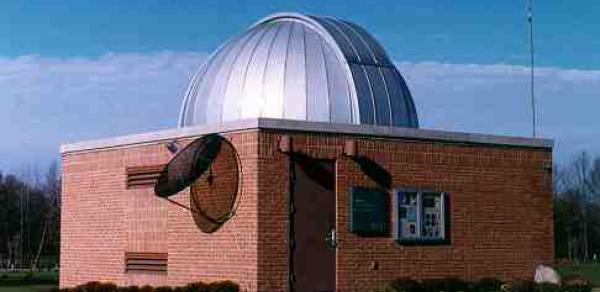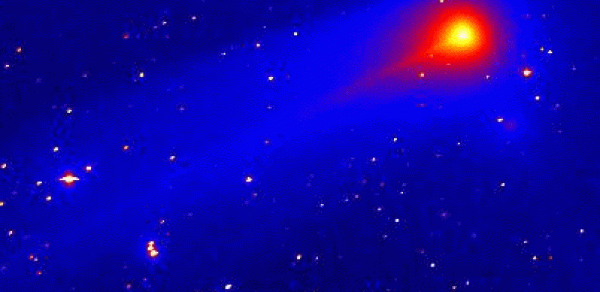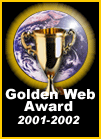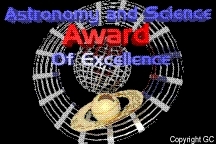Welcome to the College of Staten Island's Astrophysical Observatory Web site
The Astrophysical Observatory will be open Monday - Thursday from 8:15 - 10:00pm, through May 15th, and ONLY if it is clear out. If it is cloudy, it will not be open.
The observatory is affiliated with the Physics and Astronomy Department, as well as, sharing research opportunities for Students in the Engineering and Environmental Science Department. Also offered at CSI is an Astrophysics focus in the Physics B.S. degree (designed to prepare students for graduate Astrophysics Programs).
The observatory has been recognized as an official asteroid and comet research station by the International Astronomical Union (IAU) and assigned world wide observatory number IAU 294.
OUR OBSERVING SESSION SCHEDULE("See the SKY at CSI")AND OTHER OBSERVING OPPORTUNITIES
Tracking and hunting Minor Planets has been, and still on going, the major research program at the observatory. In addition, a number of undergraduate student reseach projects have taken place. Currently, students are building a small satellite, which when done, will be launched into space. Past projects have included, monitoring the activity of the Sun(space weather), tracking and receiving images from polar orbiting weather satellites and a GOES geostationary satellite. Our computers participate in "Project SETI" -analyzing radio waves received via the Arecibo radio telescope for possible signs of extraterrestrial life.
"The dinosaurs became extinct because they didn't have a space program And if we become extinct because we don't have a space program, it'll serve us right!" Arthur C. Clarke
Contact Information
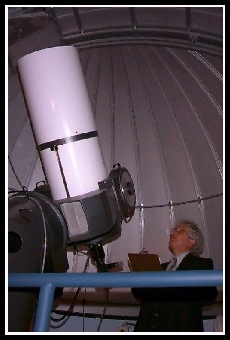 Mission Statement
Mission Statement
The College mission is to guide and assist its students in their intellectual, personal, and ethical development both for the enrichment of their individual lives and for meaningful participation in society. It is also to generate and disseminate knowledge and to provide public and cultural services to the City and State of New York.
The function of our Astrophysical Observatory, is to support the college in its fulfillment of that mission by making accessible to the students, the residents of this Island and neighboring metropolitan areas, an active dedicated on-going educational opportunity that speaks to some of the excitement of the future, some of the inherent questions of our past, and some of the environmental needs of the present.
since a counter was installed in 1998.
This website has been continuously online since 1994.
The Astrophysical Observatory of the College of Staten Island (CSI) is located adjacent to the running track on the CSI Willowbrook Campus in Richmond County, New York. The coordinates for this site are 74d 09'9.81"W Longitude; 40d 36'15.51"N Latitude; and is at an altitude of 18.288 meters above sea level. The observatory (occupied as of Fall 1996) is a 24' x 24' building with a wheelchair lift and is topped with a 16' Ash dome.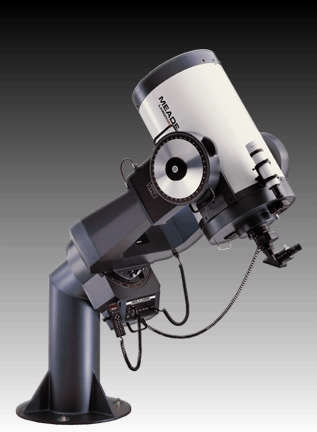
The function of our Astrophysical Observatory, located at the only public college on Staten Island, is to support the college in its fulfillment of it's mission by making accessible to the students, the residents of this Island and neighboring metropolitan areas, an active dedicated on-going educational opportunity that speaks to some of the excitement of the future of astronomy, some of the inherent questions of our past about our universe, and some of the environmental needs of the present.
The Observatory's main instrument is a Meade LX200 ACP 16-inch (0.46-m) F/10 Computerized Schmidt-Cassegrain Telescope.
Charges of the Observatory
Firstly, the observatory is the highlight of an extended laboratory component of the C.S.I. Astronomy program which serves a significant population of the liberal arts and science majors. The large number of students choosing the study of Astronomy is a reflection of their interest in the fundamental questions of existence. Astronomy casts these inquiries in a scientific context and by its nature, presents the romantic aspect of science in its investigations. Students in the program are able to explore first hand the general characteristics of our Solar System, our Milky Way Galaxy and other Galaxies.
The observatory contributes to an enrichment of one's life by focusing one's thoughts on the modern cosmic perspective. Historically, the progress of a civilization is intimately connected to the cosmological model adopted by a society. The observatory which presents the current viewpoints of our universe will help students free themselves from the yoke of fear and superstition which seems to have gained a strong grip on our culture over the last few decades.
The second charge of the observatory is to provide a link up with the local community. There are several aspects to the public function now implemented or under consideration, namely:
- Once a week for most of the year we are currently open to the general public with special emphasis of supporting the Astronomy observing sessions of the College of Staten Island Astronomy classes. Please refer to our observing schedule for more information.
- A special monthly public program of general observations; to be offered jointly with the Staten Island branch of the Amateur Astronomer's Association is being planned.
- A program under way for students at local high schools to be invited to participate in special sky observing offerings, as well as, to work in some of the research projects described in Part II of this document.
- The observatory's main computer, a SUN work station, is a general resource center for astronomical and earth science images and programs that can be reached via the internet and has already opened for public access via our Homepage. This astronomical Home Page has been setup to be a Gateway to the world of Astronomy on the Internet.
The third major commitment at the observatory is to do astronomical research (ADD LINK) with our undergraduate students. To date we have state of the art equipment partially funded by Grants from the National Science Foundation and the New York State Graduate Research Initiative Program. Our student researchers have been supported by the Diamond Fellowship Program(DFP), the CUNY Pipeline Program and the New York City Alliance for Minority Participation(AMP) in Science, Engineering and Mathematics. The DFP and AMP programs are closing and we hope to obtain future support of our students for a variety of projects by NASA and benefactor grants.
- The targeted telescopic research areas are variable star work, solar system monitoring, asteroid positions, asteroid rotation periods and near-earth asteroid searching. ADD RESEARCH LINK
- The observatory's Radio Astronomy antennas can monitor Polar and Geo-Stationary satellites and a new 12 foot radio dish being installed will participate in the world wide SETI (Search for Extra-Terrestrial Intelligence) Project. Students who use the Radio Equipment can learn Satellite communications, meteorology from space, Monitor radio sources from space like the Sun, Jupiter, Centaurus-A and maybe get a message from "ET".
- Undergraduates in Engineering, Physics, Computer Science and Earth Science are participating in acquiring and analyzing image data for professional and community publication. Approximately 30 engineering and physics students have already undertaken and completed advanced Astrophysical projects over the past four years.
Part I On the Nature of the Astrophysical Observatory
Sky Observations from an Urban Environment
 When an observer looks to the sky even at observatories on high mountain peaks one does not look at celestial objects near the horizon because the light of these objects has to go through a lot of atmosphere and the resulting visible object is distorted. In fact, the ideal angle to observe Solar System Objects is 45 degrees above the horizon even in the mountains! The higher above the horizon the better. In our area our best observing comes about when objects are about 30 degrees above the horizon and preferable away from the North East horizon (The lights from the city of NEW YORK scatter in this direction). With this in mind we oriented the observatory to optimize our observing possibilities. Thus, the CSI observatory has almost the same percentage of sky visible to it as the major observatories.
When an observer looks to the sky even at observatories on high mountain peaks one does not look at celestial objects near the horizon because the light of these objects has to go through a lot of atmosphere and the resulting visible object is distorted. In fact, the ideal angle to observe Solar System Objects is 45 degrees above the horizon even in the mountains! The higher above the horizon the better. In our area our best observing comes about when objects are about 30 degrees above the horizon and preferable away from the North East horizon (The lights from the city of NEW YORK scatter in this direction). With this in mind we oriented the observatory to optimize our observing possibilities. Thus, the CSI observatory has almost the same percentage of sky visible to it as the major observatories.
Of course, you probably have concern that the campus area within the NYC metropolitan area has "light pollution" (excessive or misdirected light) and you are correct. To improve astronomical "seeing" on the campus the observatory is located on the darkest part of the campus. It is true that with your naked eye you will not see a sky as pretty as a mountain or desert area on campus but with our telescopes, which gather from 400 to 1600 times as much light as an eye can, we can easily see many of the wonders of the heavens. For research purposes, the telescopes at the observatory will be equipped with CCD (Charge Coupled Device) digital cameras that capture images and put them into a computer. These CCD cameras effectively increase our telescope's area ten times (effectively our 16" telescope becomes a 51" one). All modern observatories use this state of the art approach to astronomical observing. A small telescope equipped with a CCD camera could pull an image of a faint galaxy out of the Manhattan skies during the full moon phase! Since the final image taken with these systems is in a computer we use can use "image processing" software to get rid of unwanted light and enhance the quality of the image.
The observatory has a dome which blocks some outside light, as well as, has a "red light" system. These precautions are all designed to give the observer maximum "night vision". Humans have very good night vision. In order to achieve night vision, light must pass through the pupil and be transduced by receptor cells in the retina. Messages sent from the retina to the brain and spinal cord begin reflexes which regulate the pupil's diameter. A fully dilated pupil lets through only about sixteen times more light than a fully constricted pupil -- hardly enough to account for the almost millionfold range of visual sensitivity. The bulk of the adjustment is done by the receptors. In the case of dark adaptation, that task falls mainly on the rods (about 120 million in each eye increasing in concentration from center to periphery). The photopigment in the rods breaks down on exposure to light and this, in turn, begins the signal that may eventually result in seeing light. Once broken down, the pigment has to be re-manufactured and stored in the rods (Vitamin A plays a role here). This resynthesis takes almost 30 minutes to get full night vision. The rods also account for the fact that red lights do not affect night vision since they are completely insensitive to the extreme wavelengths (we see these with the cones).
You might have experienced this so-called "Night Vision" effect in entering a movie theater during the day. You are at first blind but shortly you can pick out fine detail from your seat as your eyes adapt to the low level of light. It take about twenty to thirty minutes to achieve full night vision. Urban and Suburban dwellers rarely develop night vision because car lights and street lights keep us from reaching maximum sensitivity. They rarely notice the wonders of the sky. From the observatory people rediscover what our sky looks like. In fact, it is easier to learn the constellation patterns in our area because we can see clearly all the major stars that form the patterns. As mentioned above, the red lights in the observatory do not effect night vision and permit us to see what we are doing, similar to a photographer's darkroom.
When we look at images of various objects from the CSI observatory's telescopes we can use special filters to remove the main light rays of City lights which are mostly sodium and mercury lamps. For the Sun, Moon and Major Planets very little of the above precautions are necessary except for very fine detailed work since they are very bright objects. Many people are under the misconception that if they visited the Major observatories they would see these objects a lot better than at CSI. This is not true! Theoretical a telescopes ability to see fine detail (called the resolving power) is dependent upon the aperture (main mirror or lens size) of the telescope. We have for our main telescope a 16" diameter aperture at CSI. Because of the earths atmosphere Solar, lunar and planetary details are just as good at CSI as the larger major observatory telescopes! Large telescopes are actually built to observe the faintest of distant objects (galaxies etc.) because they gather more light (wider openings) then smaller telescopes.
There is more to good observing conditions than a cloud free sky. The atmosphere's freedom from moisture and dust is called transparency and causes us the most problems in this area. The atmosphere's freedom from turbulence is called "seeing" and causes problems all over the world. Good transparency or seeing is needed depending upon different types of astronomical observations. Faint objects demand good transparency, hence, large telescopes are built in places that minimize this effect. For detailed viewing one needs good seeing. Lunar, planetary and bright nebulas and stars do not require excellent transparency because we are dealing with bright objects. They are so bright that sometimes we have to use filters to cut back the light received in order to see details on the campus.
In general, on cloudless nights our "seeing" is pretty good, especially from September to May when we will do most of our research work. Over the years we have noticed that we do get exceptional days and these have given us the best views of our solar system and beyond. All of the "bad" atmospheric effects are minimized the closer one works the telescope to the zenith (the point directly over our head) and this will be the case for the major research projects. There are some "bad" lights on our campus that effect the depth of space we can penetrate out to. A few of these interfering lights have been corrected but a fairly large number need further changes and it is hoped this will take place so that the observatory can reach its theoretical potential for observing dim objects.
Part 2 The Observatory Structure
The Observatory Structure
The dimensions of the observatory are 24-ft. by 24-ft. with a 16 ft. diameter dome. The main optical instrument is a computerized 16" f/10 Schmidt Cassegrain Telescope described below. The observatory is linked via ETHERNET to a well equipped astrophysical Laboratory (in building 5N) known as the "warm room". The warm room/Observatory setup is because observatories have no heat (or air conditioning) and are designed to keep ambient temperatures for their equipment year round. Remote operations of the observatory from the warm room are for human comfort during the coldest days of the year . This past year days extremely cold enough to use the remote facility did not appear and heavily dressed astronomers ran the observatory drinking lots of hot chocolates.
We have installed a traditional observatory dome which is motorized and under the control of the main telescope operator. The dome is a universal symbol of astronomical work and has added a scientific ambience to the new campus. The new 12 foot Radio Dish should add to this image. One can see that the main telescope is attached to a custom heavy duty metal pier which sits upon a large mass (called an inertial foundation) which is not attached to the building. This arrangement will mean very steady viewing for high magnification work which promises us very spectacular views of the Sun, Moon and Planets, as well as, permitting meaningful research.
You can see from the figure that if you want to view the heavens directly from the main telescope you have to get up to an observatory deck. A curved spiral concrete stairwell from the door pictured brings one up to the deck (not seen in the figure). We installed a special electric lift that runs on tracks at the side of the stairs for wheelchair bound individuals so that they can get to the observation deck. As far as the author knows, this handicap access arrangement is unique in the astronomical world.
Part 3 The Main Optical Telescope
Main Optical Telescope
The 16" Meade Schmidt-Cassegrain astronomical telescope shown to the left is our primary viewing device. A 16" mirror is the main focusing device located within the telescope. The telescope is fully computer controlled with over 64,000 celestial objects in its memory. The computer gives us tremendous power. It permits very accurate alignments, as well as, rapid finding of celestial objects. This computerized locating ability permits us to view objects in our urban skies which would be otherwise very difficult if not impossible in previous generation telescopes. 
This speedy technique of obtaining objects results in eliminating much of the time consuming mechanical drudgery that many people have experienced with setting up and operating astronomical telescopes. Even a novice can simply control the computer console to view an on screen sky map and with a mouse quickly find what they are interested in. A simple "click" and the telescope will go to the object of interest. In order to make this possible the telescope has to be aligned to a very high precision with the sky. The custom steel piers pictured in the previous figure will make this task very attainable. When lots of people want to view through the telescope, saving time becomes a premium. By finding objects quickly, the educational capabilities of this system are extremely enhanced.
The chosen Meade 16" telescope is the finest commercially mass produced telescope in its class for university research programs. For the planned laboratory and research work, some modification were a must. We have obtained the telescope from the "California Telescope Company" with the following modifications to ensure success for the observatory objectives.
1. As mentioned, the observatory was planned around the customized permanent steel pier that the telescope sits upon. The pier in addition to being massive is latitude and telescope specific.
2. Special software for local computer control of the telescope has been provided.
Part 4 CCD Cameras:
CCD Cameras:
Imaging Systems and Photometric Measurements
The recent electronic breakthroughs now permit small observatories to use equipment previously only available to major observatories that could afford very expensive equipment. As mentioned above CCD imaging systems capture images electronically and store an image in a computer to allow one to enhance it. Once we have stored images in our computer showing what we are doing, we are free to display them on high resolution monitors. We also have stored most images taken by NASA and the Jet Propulsion Laboratory. (Visitors who come during the day or on previously scheduled night that turns cloudy or rainy can still give get a presentation of magnificent views of our solar system and the universe.)
CCD images are many times more efficient than photographic films which results in markedly reduced exposure time. For example, a fast film used to photograph Saturn might require ten minutes but with CCD we do the same job in ten "seconds"! Most light pollution in our images can now be subtracted out. Even an out of focus image can be changed using image processing techniques. Faint details in images can be brought out by using a variety of coloring techniques in conjunction with mathematical methods built in to our image processing software. Positional and brightness data can be obtained via software. In other words, this system is an extremely smart "camera" for the observatory.
A major field of astronomical measurement that will take place at the Observatory is "photometry" which requires obtaining the brightness of a celestial object called its magnitude. The CCD camera systems we have, as well as, a dedicated photometric camera are designed to carry out this work. Many of our planned research projects require measurement of celestial brightness. Essentially the observer centers the object of interest into the Photometer instrument which is attached to the telescope and gets a reading on the objects brightness. The data obtained is then sent to the computer for data reduction which produces will known standard meaningful results from the raw experimental data.
Part 5 Portable Observatory Systems
Portable Observatory Systems
For the observatory to be an extended laboratory setting for astronomy, we have purchased via grants, additional telescopes, CCD cameras, laptop computers and customized battery packs. Four complete portable systems(mentioned above in the general imaging section) have been assembled. They have been used with great success by our students. The are based upon Meade computerized 8" and 10" Schmidt Cassegrain Telescopes and the Meade Pictor CCD camera. These systems will be used as training systems for our research students and by the general astronomy classes, as well as, in a special observing course for observing projects and laboratory exercises.
Listed below with explanations (if needed) are 21 representative types of exercises to be undertaken with the portable systems and in some cases in conjunction with the CSI Astrophysical Observatory..
- Alignment and use of astronomical telescopes.
- Telescope field of view (observable widths) and 'Light Gathering' power (faintest stars visible). Including effects of magnification on image contrast and faint star viewing.
- Constructing star charts
- Star finding and Celestial Navigation
- Basic Telescopic observations of the Sun, Moon, Venus, Mars, Jupiter and Saturn.
- Lunar features; mountains, valleys, Maria and craters. i.e. general appearance.
- Lunar topography. Measurement of length, diameter, height and estimates of age of lunar features.
- Lunar Occultation timings. (The result of the moon passing over a star or planet).
- Comet observations and magnitudes(brightness).
- Observations of the Galilean satellites of Jupiter.
- Observations of stellar colors, spectra studies and stellar classifications.
- Solar surface features as sunspot structures and counts, faculae(bright regions), prominences and granulation (convective effect of outer solar atmosphere) of the photospheric layer. Special eye protection equipment, as well as, single wavelength detection systems are used here.
- Cluster (group of stars with common distance and motion) studies and the H-R diagram (a key understanding of stellar types and evolution).
- Determining the period and amplitude of the variable star Delta Cephei. A famous case!
- Observations of double stars (close stars that may or may not revolve around each other).
- Observations of Galactic Nebulae (birth places of stars). For example. the Orion Nebulae.
- Observations of Globular Clusters (old associations of stars in spherical shapes)
- Observations of Planetary Nebulae (some stars have a ring of gas around them as part of its aging process).
- Observations of extra-galactic systems ( capturing images of the Andromeda galaxy and others).
- Celestial Photography
- Photometric Observations of Intrinsic Variable stars as well as Eclipsing Binary star systems. Using our photometers students observe stars that are unstable (the variables), as well as, stars (two) that go around each the binary stars) and block each other analogous to the moon in front of the sun (solar eclipse). Detailed curves showing the light variation, as well as the nature of these objects will be explored.
Part 6 Planned research Programs and Projects
Some Long Run Plans
Environmental Projects: The observatory is in a unique position to examine the solar spectrum at sunset and with proper spectroscopes one can determine the types and concentrations of air pollutants in the New Jersey/New York atmosphere.
Attracting Physics Majors: The potential to do astronomical research will attract active young faculty to our institution. In addition, the observatory will be a catalysis to attract Physics majors. Since the school is a CUNY one, we expect more minority representation and participation in this area.
Teacher preparation:The observatory can function as an exciting catalysis for courses in space-science for primary school teachers and the establishment of an Astronomy/Physics minor for secondary teachers.
Research Projects
The general research projects listed below will give you an idea of the scope of the capabilities of the Observatory. Many of these projects have already been started.
I. General image processing
The Main 16" telescope, as well as, small self contained astronomical systems (consisting of a portable computerized telescope, CCD camera and notebook computer-all battery powered) obtained by a recent NSF ILE-IG grant awarded the author permits a variety of image processing projects. Furthermore, the observatories Weather satellite receiving hardware and software (geostationary and polar) equipment extends projects to images obtained by students from satellites.
The observatories professional scientific image processing software (MIRA and Imagine 32 -Pro for the 486 computers and various packages for the SUN workstation) make image processing projects more feasible for students.
The diverse CCD cameras available ( We have seven cameras ranging from basic to professional sizes) attached to the Main telescope or the portable telescopes can capture images of lunar features, planets, variable stars, clusters, and galaxies. The image data in addition to be taken at the observatory can be obtained at remote sites with the use of the portable systems. The final astronomical images and associated image files can be brought back to the astrophysical laboratory computers for exhibiting, processing and analysis.
Because of it's advantages over photography the CCD camera has been adopted by all major observatories. The high quantum efficiency, dynamic linear responses and broad sensitivity to light of these cameras will permit us to undertake the experiments listed below in relatively light polluted skies1,2,3.
In the last two years, a number of CCD devices have become commercially available4,5,6. These latest low-cost CCD cameras have made it possible for college observatories and amateur astronomers to perform tasks that until recently only major observatories carried out.
Committed research students can easily learn all the necessary concepts for obtaining and analyzing data and setting up and using the telescope, CCD camera.
It is our experience that it takes about a year for a student to be very proficient in the use of these systems.
II Photometry of Stars
The professional level image processing and analysis packages have photometric capabilities, as well as, image processing tools. The scientific grade astronomical filters( BVRI) and filter wheel holders to be used with the CCD camera will permit us to undertake a number of photometric projects.
The initial learning process will involve picking as targets well known short period variable stars or binaries (RR Lyrae stars, W Uma binaries) and obtain differential magnitudes, the resulting light curve results in ascertaining the period( variability time) of these stars. The software permits one to relatively easily obtain very good differential magnitudes. It is even common for researchers to publish differential data. This initial process will be extended to the standard photometric system for comparison of results with other observers, 8, 9.
Among the research targets will be Long Period Variables. The director has learned there are professional astronomers who are not getting enough time at major observatories and who need good data on stars of interest 10, 11.
Small college observatories fit the needs of those who want more time data for their research . After the initial learning process a student will be ready to handle our 16" telescope and its associated equipment and thus be able to contribute to the research community valuable data on the long period variables.
III Photometry of the Solar System
A great deal of work is needed on the Planets, their satellites, as well as, asteroids and comets. Recently, monitoring of IO during the Galileo Mission was called for 12,13,14. The solar system objects are bright and easily visible targets. There are numerous opportunities. Variations of targeted objects can monitor reflectivity, chemical composition and solar activity. An Asteroid Rotation project has recently been started by an engineering student as part of a fellowship(CUNY Pipeline) program.
IV Asteroid Parallaxes
Determining parallaxes of asteroids and the resulting distances has recently become another area of research opportunity for college observatories. It is actually less demanding than photometric projects. Small telescopes equipped with a CCD camera are now powerful enough to detect hundreds to thousands of asteroids. The CSI observatory in conjunction with other observatories can coordinate asteroid observations to obtain accurate parallaxes. Several recent publications deal with this topic in detail 15,16.
V Asteroid Hunting and Discovery
We can use this CCD equipment in the search for asteroids (chunks of matter) that cross the earth's path in space. The rapid acquisition of pictures will permit us to see the paths of these rapidly moving objects (a matter of hours or days). Recently a number of asteroids were accurately tracked and their positions were measured to high precision. The results of the latter work were published by the International Astronomical Union headquartered at the Harvard- Smithsonian observatory in their Minor Planet Circular journal. We expect to extend the hunting to discovering new near-earth asteroids that could possible pose a threat.
VI Comet and Supernova Discovery
The same techniques used for Asteroid work above can be applied to discovering new comets that enter our solar system. Supernova can be found by CCD imaging and monitoring of galaxies.
VII Radio Astronomy
A number of years ago Nobel Laureate Roger Penrose gave the department a number of items for a branch of Astronomy Known as Radio Astronomy. In addition to the gifts, students designed and built a special antenna to collect radio data from the sun and Jupiter. This past year we revised this aspect of undergraduate research. We current have in operation a 6 foot dish to pick up Geo-stationary Satellite relayed information. We have a small "Yagi" antenna to track and obtain images of American, Russian and Chinese polar satellites. We currently are installing a 12 foot computer controlled dish designed by one of our engineering students as part of a design project. The 12 foot dish system will be used in a cooperative program with the Planetary Societies SETI league. Students who use the Radio Equipment can learn Satellite communications, Monitor radio sources from space like the SUN, Jupiter, strong source of radio energy like Centaurus-A-A and maybe get a message from "ET".
The Weather satellite receiving hardware and software (geostationary and polar) equipment at the observatory will permit the study of the atmosphere, ocean currents and general meteorology. Recently, students tracked hurricanes with this equipment.
Dissemination
The director intends to disseminate the results of the astronomical research by the publication of articles in journals such as, Publications of the Astronomical Society of the Pacific, Communications of the International Amateur-Professional Photoelectric Photometry, The Journal of the American Association of Variable Star Observers. Minor Planet Circular of the International Astronomical Union, Lunar and Planetary Observers Journal
